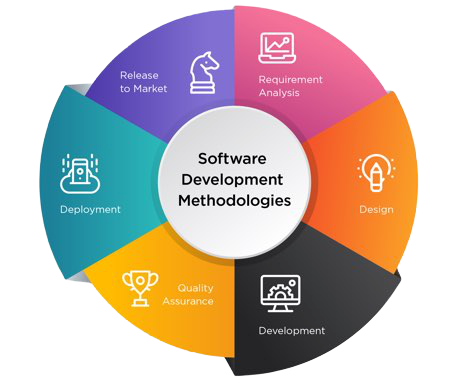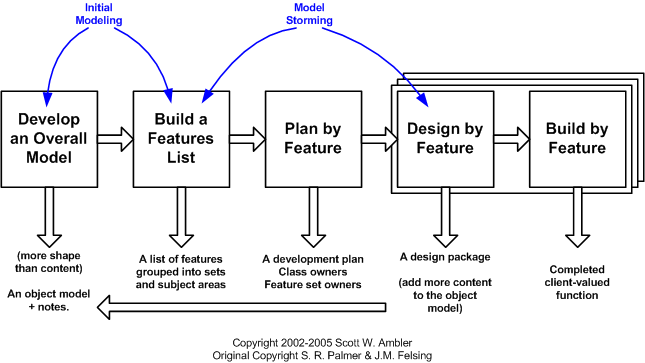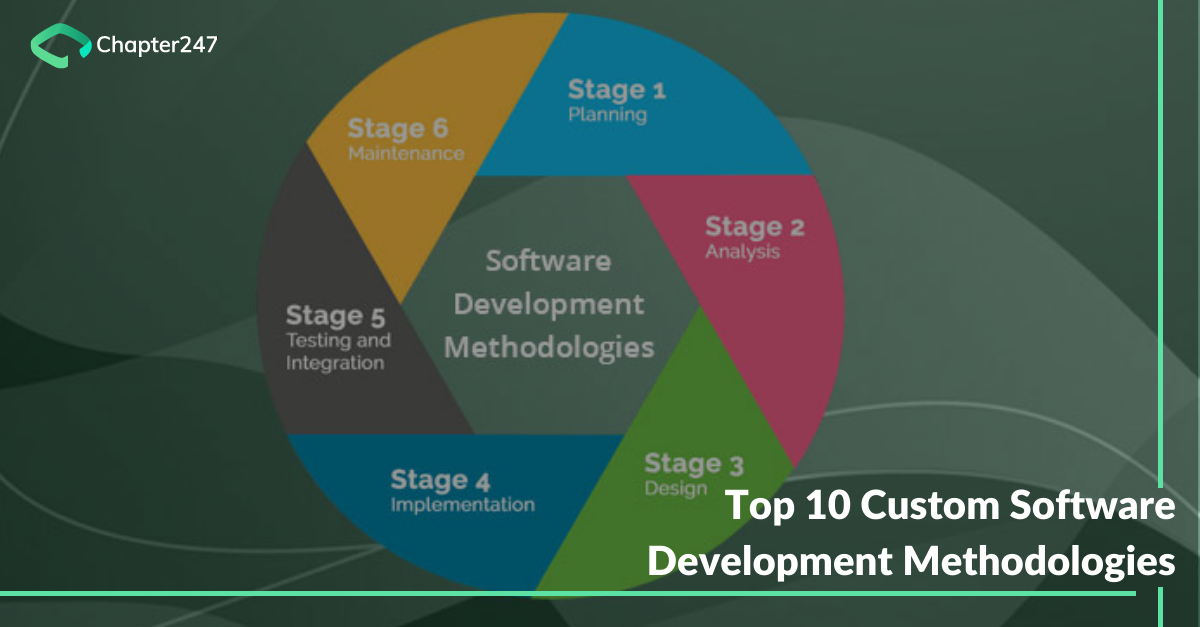Custom software development methodologies play a vital role in developing software constructed according to your needs. It is said that if the start is good, then the end has to be good! The same rule applies to custom software application development where the style of management and the system put to use will have an important bearing on the success of your project.
It is very important that the goals, definitions, and objectives of the projects are clearly stated at the nascent stage of the project. To decide on a development methodology to build custom software is an important decision. This decision can only be made after every bit of the project has been studied intricately. Once the complexities, client demand, and resources are sufficiently analyzed, custom software application development companies can finally initiate the beginnings of the project.
But before we do that, it is important to detect the different methodologies and how they might fit in your project and its ideologies.
Top custom software development methodologies you can employ
Big Bang Methodology-
This methodology is for those simple and small projects where the client is unaware of what the requirements are how the project has to take shape. It has no rigid formal protocols and is quite uncomplicated.

Source: ProfessionalQA
Pluses:
- The model is very simple to use because proactive planning is not required as much as it is required in other methodologies.
- It is also very manageable as the resources required are very minimal.
- For beginners to augment their skills, this model can help them with the necessary exposure.
Minuses:
- It can be a risky model for complex projects. It is recommended only for smaller and fewer complex projects.
- If the needs of the client are not deciphered sufficiently, it is quite possible that the project might end up getting scrapped.
Prototype Model
Software development implies that there are various processes involved in the creation of a program that has to be carefully evaluated stage wise. If one wants to create a good prototype of the software then it is important that the requirements of the software are understood and requisite market research has been conducted. This is the basic essence of the Prototype model which allows developers to create only the prototype of the solution basically to demonstrate to their clients. The necessary modifications can be added based on the feedback of the client.

Source: Guru99
The flow of the methodology also is as follows:
- The prototype has to be created
- Once that is done the client will be called in for scrutiny at his level
- If the client has completed the review, then the necessary changes are requested by him.
- The changes requested will then be applied in the development phase of the project
- After the development has been completed, the maintenance stage comes which can be ongoing depending on the nature of the project.
Pluses:
- When there is a prototype you can instantly show it to the client. The client can then understand if the application development is going along the right path or not.
- When you make a prototype and get it analyzed by the client, it reduces the chances of failures because the client has already corrected you.
- One of the biggest advantages of using this model is that gathering requirement strengthens which ensures your documentation is up to date.
- The client and the organization are not merely sharing a top-down approach. They are partners in software application development which is a necessary ingredient in software development.
Minuses:
- The resources and costs involved in developing the prototype can be a burden on your budget.
- If the client has recommended several changes, then the entire workflow of the project will be disrupted.
Waterfall Methodology
The waterfall methodology is the most popular and oldest methodologies for custom software development. It represents the classical life-cycle approach to software development. It is a rigid model that follows a definite pattern. One cannot supersede any phase. One phase has to follow the other and that is a prerequisite condition. The sequential flow of the waterfall methodology encourages the software development company to follow the rigorous procedures and that no functionality can overlap the other.

Source: Airbrake
The waterfall method has stages which the developers have to follow. Remember, only when one stage has been completed can the developer jump to other stages. These stages are
- Consulting the client and getting his requirements
- A sampling of the module
- The enforcement of the plan
- Testing the software
- Without a doubt its maintenance
Pluses:
- It is suitable for projects of all sizes and difficulty levels
- It has a great functional value because it is very simple to follow
- The model is rigid, while that can be a minus too, but in this case, the stages are predictable and developers can work in their comfort zones
- Since the stages are well-defined, there is a lot of time-saving
Minuses:
- For longer projects, this is not recommended as for ongoing projects the requirements keep changing.
- Only if the requirements are clear-cut can this methodology succeed. Any hint of vagueness or uncertainty will not gel well with this method
- You will never know how the development of custom software is progressing unless the testing stage. Till then you can only assume it is fool-proof.
Agile Software development methodology
Change is permanent, especially in technology circuits. While the project is being developed the Agile software development methodology allows for intermittent adjustments in custom software development. In order to inculcate the changes time and again, it is required that the model be flexible. The agile software development method is the key to such a requirement. It helps in the reduction of risks because it enables developers to create custom software in tiny time boxes known as iterations.
Usually, Agile software development includes under its bracket a sequence of unique methods and practices. These unique methods are directly proportional to the values that are expressed in the Agile proclamation. During the entire software development cycle, issues with the best-fit solutions will emerge and the different teams involved in custom software development will utilize these practices.
The biggest plus point of this is that the developers are able to give a scalable response to the new transitions so required in custom software development. There is no rigid framework within which you need to work on.

Pluses:
- The agile software development method is extremely famous mainly because the issues start cropping up at the earlier stages can be resolved then and there. In short, it is an adaptive method that responds to the changing needs of the project.
- It also helps developers to be creative with modifications in the design code helping in improving the overall experience
- The Agile methodology has two-way communication. The client and service provider communication is constant where the scope of regular feedback is more and improvements are at its peak.
- Before the iteration, the costs of the project and using this development methodology is understood. This helps the team to understand where they need to save and where they need to infuse the resources.
- As the custom software development project is divided into smaller parts, managing and testing them becomes easier. This ensures the accuracy of the project along with the assurance that the project so delivered is of superior quality.
Minuses
- Sometimes the changes are so often that the project can go haywire if not controlled by a mechanism.
- The methodology focuses most of its attention on the software development part neglecting the importance of documentation.
- If the client is not very clear about his needs and the end result of the project, then the entire cycle of events will suffer. It will have a ripple down effect on the application development. Everything will then have to be executed from scratch.
- Since it does not have a solid structure and emphasizes too much on flexibility, it can hamper some projects
Rapid Application Development Methodology (RAD)
This is one methodology that focuses on the rapid development of your project. It takes inspiration from the prototype model as well as the agile software development methodology to create faster iterations and creating prototypes that can be released rapidly. Why does it do that? The answer is faster acceleration in the speed of the Software development lifecycle. It leads to quicker feedback, faster correction of errors and reaching your goals as fast as possible.

Source: ResearchGate
Pluses:
- Since the feedback keeps coming in, the review is faster followed by quicker resolutions
- For further improvement, customer feedback is constantly taken and applied before implementation.
- Exorbitant errors can be avoided thanks to its stage-wise testing
- The system is also transparent and allows the client to keep a tab on the progress
Minus:
- It is surely not apt for small projects and the requirement for highly skilled professionals is the key to conduct this methodology
- It is suitable for those projects which can be split into standardized units
Dynamic Systems Development Model Methodology
The main takeaway of this model of development is restricted budget, rigid time frame, and high user-involvement. The purpose of the Dynamic systems model is to ensure that continuous feedback flows in the system, user involvement is high which ultimately leads to maximum functionality.
This methodology of software development is part of the Agile Development methodologies where each individual methodology has its own principles and a unique approach. These also have similar features to each other like goal orientation, lightness, flexibility and a focus on continuous development. The DSDM methodology is based on the RAD model and encourages involvement by the user. Among its goals is to develop and to provide software models within the specified budget and within the deadlines. The thought that governs Dynamics Systems Development Methodology is that software development is a constantly changing process as it needs more than one attempt to gain success.

Source: Tatvasoft
Pluses:
- You can arrive at the desired functionality thanks to the incessant exchange between the user and the custom software development team
- The project is delivered intermittently. The primary requirements are given first followed by the later stages which are also provided in a structured timeline pattern
- Since the budgets and time frame is specified, developers will be able to develop the project on time and also ensure that the costing doesn’t exceed the budget
Minus:
- The approach is not suitable for a small organization as the costs are sizeable. It is costly to implement.
- There is a dearth of an expert who follows this methodology as it is yet raw in the market
Scrum methodology
As the Agile software development methodology, Scrum also ranks high in popularity. In order for it to achieve results, the model divides the working processes into small bits. The work order for each bit is decided pre-hand and then later deliberated after the bit has been executed. It can be applied to almost all projects, especially the ones that have rapid transformations. The model sequences as follows:
- Planning – Planning can be detailed or brief or a combination of both
- Meeting – regular meetings which will ensure that changes are made then and there without the need for going back again
- Conclusion – the final review is very important that comes third in the series of sequences.

Source: CovetusLLC
Pluses:
- The team involved in custom software development is responsible for decision making.
- Since the feedback cycle is swift and calls for change at various stages, the project can progress as per the desired route.
- In order to maximize individual productivity developers and clients interact at regular intervals so as to ensure that the snags reduce and the client gets what he wishes to.
Minus:
- If the time of the project and the budget has not been specified earlier, the project might suffer
- It is not suitable for cost-effective projects
- Scrum methodology is suitable for projects which are handled by technology bigwigs. A little less experience will be detrimental to the project.
Joint application development
The need for this approach is to have continuous interaction between developers, designers, and users. During the development process, there are several workshops conducted to get the gist of the project. In these sessions, the stakeholders are end-users, mediators, observers, facilitators and a team of expertise. The main focus of this approach is to reduce and eliminate as much as possible errors that may arise in the earlier stages of custom software development.

Source: Study.com
Pluses:
- The errors are eliminated at very early stages
- Precious information is restored thanks to these workshop sessions.
Minus:
- The planning stage can be burdensome. Its execution can get very cumbersome.
- This methodology also requires the presence of an expert panel who will run the project
Spiral Model
The spiral model was developed with the aim to eradicate errors at the early stages of custom software development. The development starts from smaller aspects of the project and then moves to bigger modules so that a systematic flow is carried forward. At every stage feedback is sort and the errors are countered in that stage itself. The errors will not be carried away to other stages at any cost. The project moves spirally from one stage to another, eliminating risks and injecting feedback.

Source: Geeksforgeeks
Pluses:
- Costs can be estimated easily in the case of this model
- The breaking up of parts ensures that risks are eliminated at early stages
- Since everything is systematized, the development procedure is highly disciplined and the flow is linear
Minus:
- It is not suitable for smaller budget projects
- There is a definite chance of going over the timeframe and budget in the case of the spiral model of development.
Feature Driven Development
Based on user feedback features are added into the system. The entire execution of the project from designing to the building is all feature-based. In order to augment productivity and functionality, this methodology involves the use of iterations. This also helps in dealing with multiple complexities. The main purpose of this strategy involves feature-driven development and organizing the work of a large number of teams within the auspices of the organization.

Source: Agile Modelling
Pluses:
- It is a great method which can be employed for bigger projects
- Since the SOP is pre-defined the developing procedure is highly simplified.
Minus:
- Not suitable for smaller organizations at all
- If and only if your lead expertise is following the project, it is feasible to use this method
- The method doesn’t warranty that it will adhere to any strict deadlines
Final Word
To reach the desired level of results in the development procedures, it is essential that appropriate custom software development methodology is employed. We at Chapter247 recommend organizations to spend quality time of goal definition, objective singularization, budget estimation and bundling up of the team to lead the project.
The graph gives a hint on which methodology is hot and which is not, but the ultimate deciding factor has to be the nature of your project.
It is the mere fact that every system adopted has its set of benefits and disadvantages, but organizations then have to make the best fit possible. It is required that you scrutinize each and every aspect of the methodology before your final words.








